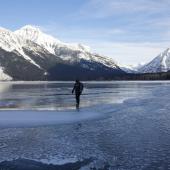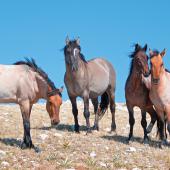A Journey on Montana’s Missouri River Ferries

Few of us give a thought to crossing water, as we cruise the highways and cross modern bridges. But in the 1800s, fording a river could be a dangerous and even deadly ordeal. River ferries were the first major improvement to make that task much easier. Today in Montana, three ferries still operate on remote stretches of the Missouri River, giving travelers a chance to slow down, experience a taste of history, and soak in some beautiful country.
Setting out to explore all three of Montana’s ferries, our journey began in the river canyon of the rugged, broken and relatively unspoiled country known as the Missouri Breaks. Lewis and Clark came through this part of central Montana on their epic journey to the Pacific. A dirt road offers modern day adventurers a scenic drive through this beautiful area, much of which is now protected as a National Monument. In fact, this part of the world is so isolated, that when the dirt road reaches the water’s edge, you’ll discover there’s no bridge—only a ferry.

The setting sun softens the rough terrain, painting the hills in the warm glow that makes for great photographs. The ferry is on the far side of the river when we pull up. But soon, the diesel-powered barge chugs across the water with friendly operator Jack Carr at the wheel.

“They planted bighorn sheep, reintroduced ‘em here about 30, 35 years ago,” Jack tells us. “They are the predominant animal around here right now.”
Dressed in a baggy T-shirt and shorts, Jack is a former smalltown school teacher, who genuinely enjoys piloting the ferry. “Just visiting with people is interesting,” he says. “And I always ask, ‘Where you coming from and where you going?’ And everyone’s got a story to tell ya. And they want to know about the history of the ferry.”

Homesteader Jack McClelland put the original ferry in back in 1921, and later sold it to the Stafford family. Today the McClelland/Stafford Ferry is owned by the county. The boat runs from the first of May to the end of November. “There’s a bridge up river about 13 miles,” Jack replies, when asked why there’s no bridge here. “But they just don’t want to disrupt this section of the river.”

Just eight to 10 vehicles cross on an average day, many of them tourists. But local ranchers use the ferry as well, which cuts off an hour on the trip to Billings for those north of the Missouri.
Montana’s two other working ferries are upstream from here. Furthest away is the Carter Ferry, outside the tiny town of Carter, 25 miles northeast of Great Falls. The placid stretch of river there runs through country not nearly as dramatic as the Breaks. But it’s beautiful in its own way. After all, we’re in Montana!

The patient ferry operator lets us cross over and back, just so we could say we did, and get pictures as well. Then we’re back on the highway to head downstream to the Virgelle Ferry, the last and perhaps most memorable crossing.
“Probably one of the most beautiful places in the world here,” our ferry operator Jimmy Griffin observes, as another setting sun paints the sky with amber rays. “The more I look upstream, the more I remember how pretty it is.”
The fading sunlight softly reflects on the quiet water, the river banks now just a darkened silhouette. The only sound is the muffled purr of the ferry engine, sounding like the outboard motor of a fishing boat on a deserted lake.

The peaceful scene is a rare experience for urban dwellers. And just a stone’s throw from the water is something even more unusual—the resurrected ghost town of Virgelle. Founded in the early 1900’s, it’s home to one of the most unique bed and breakfasts in the country, where you can spend the night in a real homesteader cabin.
“People say, ‘Who comes here? How do you sell anything?,’” says our host Don Sorenson. “Our location is probably our best asset.”

The grandson of Montana homesteaders, Sorensen grew up on a farm six miles away. He became a pharmacist instead of a farmer, but had a lifelong interest in collecting and restoring antiques. “I started restoring things on the family farm when I got out of pharmacy school,” he recounts. “My dad thought I was crazy.”

Don grew up visiting Virgelle, founded by Virgil Blankenbaker around 1910, during Montana’s homesteader boom. A sturdy bank opened for business in 1917, joining the general store as the two main structures in town. But by the 1920s, drought and economic depression had driven off most of the local homesteaders. The bank shut down in 1927. The post office closed in 1961. The general store was shuttered nine years later. And the railroad line was abandoned in the 1980s.
All the while, Don’s antique collection continued to grow. “I’d filled up the attic of the barn,” he tells. “The general store was abandoned… and I thought… ‘Hmmmmm.”

He bought the store and spent three years turning the abandoned mercantile into an antique shop. It took another decade to restore the dilapidated rooms upstairs, where railroad workers had once slept. Today those guest rooms are exquisitely restored, each named for someone who once called Virgelle home, like the Blankenbaker room.
At the same time, the busy entrepreneur was breathing life into a collection of abandoned homesteader cabins. And Don didn’t have to go far to get started. “There was a bunkhouse on the family farm that was actually a homestead cabin,” says Don. “I fixed it up and moved it down here... and then one thing lead to another.”

Today the Virgelle Merc offers six meticulously restored cabins that Don recovered from the surrounding Montana countryside. He also converted the old Virgelle ice house, that once stored blocks of Missouri River ice, into state of the art bathroom facilities for the restored cabins. And each cabin is named after the family that built them.
Along with the general store, Don has restored the bank to house his many antiques. Together with the homesteader cabins, Virgelle is a destination for those looking for a unique, historic overnight experience, as well as attracting antique hunters from all over the country. (Go to www.virgellemontana.com)
In the process, his impressive achievement has saved a piece of our history, given us a taste of the past, while creating cherished, new memories for those fortunate enough to visit today.
It all begins with turning off that beaten path, and discovering the quiet gems tucked away on the back roads of Montana—like that short but profound ferry ride that takes you across the Missouri to Virgelle. A ride on any of those three river ferries forces you to slow down, get out of the car and experience the quiet beauty of Montana, simple pleasures we so often miss, as we speed along in our busy lives.

• • • •
DMd • Spring 2018
Crossing the Missouri River by Ferry
Step back in time and experience Central Montana's three river ferries as you cross the Missouri River. Ferries are located at Carter, Virgelle and north of Winifred.












- Reply
Permalink